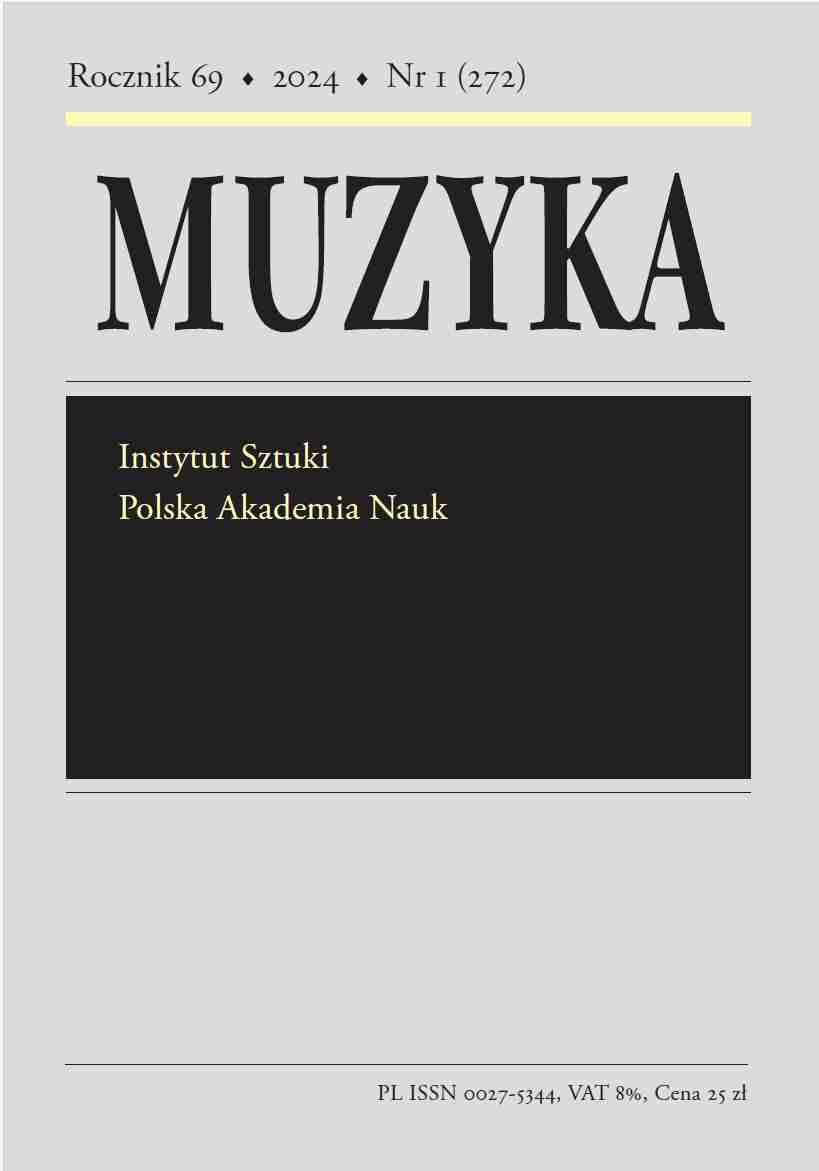Podążając śladami dźwiękowej wyobraźni. Muzyka Witolda Lutosławskiego w słuchowiskach Polskiego Radia
Abstrakt
Radiowa twórczość Lutosławskiego należy dziś do najmniej zbadanych obszarów jego użytkowej działalności kompozytorskiej. Pracę w Polskim Radio rozpoczął w 1945 roku początkowo pełniąc funkcję Kierownika Działu Muzyki Poważnej, szybko jednak objął stanowisko kompozytora muzyki do słuchowisk. Pisaniem muzyki do audycji radiowych zajmował się do 1960 roku, mimo, że jego etatowa praca w Radiu zakończyła się w 1958 roku. Powstało w tym czasie ok. 86 audycji z jego muzyką, z czego do dziś zachowały się 33 nagrania (w warszawskich archiwach) oraz 46 partytur (w Bazylei). Niekompletność źródeł w dalszym ciągu utrudnia rekonstrukcję całego repertuaru, w tym precyzyjnego ustalenia chronologii powstania dzieł, nazwiska ich autorów oraz reżyserów. Mimo to, w wielu przypadkach udało się zweryfikować wiele informacji na temat tej twórczości. Niezwykle cennym dokumentem, odnalezionym w toku badań nad dziełami radiowymi, jest roboczy tekst Lutosławskiego pt. Rozważania teoretyczne. Stanowi on jedyne zachowane źródło odkompozytorskie, w którym prezentuje on swoje przemyślenia o roli muzyki w słuchowisku, odnosząc się do własnej praktyki kompozytorskiej.
Lutosławski, w tworzonych opracowaniach muzycznych, charakter muzyki uzależniał od typu audycji. Nadrzędny podział wynikał grupy odbiorców. W audycjach dla dzieci muzyka ma więcej cech ilustracyjnych, oddziaływujących na dziecięcą wyobraźnię. W przypadku słuchowisk dla dorosłych, różnorodne konwencje muzyczne wynikały z rodzaju i tematyki dzieł. Audycje z cyklu Poezja i muzyka, zawierały zwykle krótkie intermezza, mające za zadanie podkreślić nastrój wierszy oraz wypełnić przerwy pomiędzy recytacją zwrotek. Wśród pozostałych dzieł wyróżnić można audycje o tematyce mitologicznej, historyczno-legendarnej, ludowej oraz groteski. Stosowanie za każdym razem różnorodnych rozwiązań formalnych, stylistycznych, przy różnicowaniu funkcji muzyki, przekładało się na indywidualność warstwy muzycznej. Skala opracowań muzycznych sięga od bardzo prostej melodyki, tonalnej harmoniki, czasem zamierzonej archaizacji, poprzez muzykę w neoklasycznym stylu, do współczesnego języka (poszukiwania harmoniczne i brzmieniowe). Nie sposób doszukiwać się tu jakiejś linii rozwojowej warsztatu kompozytora. Z pewnością wiele z partytur stała się polem do poszukiwań fakturalnych, rytmicznych, harmonicznych, itp., Ponadto, ich tworzenie dawało kompozytorowi wsparcie finansowe, szczególnie ważne w pierwszych latach powojennych.
Instytucje finansujące
Statystyki
Abstract views: 234PDF downloads: 172
Licencja
Prawa autorskie (c) 2024 Wioleta Muras

Utwór dostępny jest na licencji Creative Commons Uznanie autorstwa 4.0 Międzynarodowe.
Autor udziela wydawcy niewyłącznej i nieodpłatnej licencji (CC BY 4.0) na wykorzystanie tekstu w „Muzyce”, zachowuje nieograniczone prawa autorskie i zobowiązuje się do podawania miejsca pierwodruku w „Muzyce” przy ponownym wykorzystaniu artykułu (umowa licencyjna do pobrania). Zgłaszając artykuł do publikacji, autor wyraża zgodę na jego udostępnianie na licencji CC BY 4.0.
Artykuły w zeszytach od 2018/1 do 2022/3 publikowane były na licencji CC BY-NC-ND 4.0. W tym okresie autorzy/ki udzielali wydawcy niewyłącznej i nieodpłatnej licencji (CC BY-ND 4.0) na wykorzystanie tekstu w „Muzyce”, zachowywali nieograniczone prawa autorskie, ale zobowiązywali się do podawania miejsca pierwodruku przy ponownym wykorzystaniu artykułu.
Inne teksty tego samego autora
- Wioleta Muras, Koncerty na fortepian Aleksandra Zarzyckiego. Nowe fakty w świetle źródeł , Muzyka: Tom 67 Nr 4 (2022)
- Wioleta Muras, Dwie wizje muzyki. Partytury Zbigniewa Turskiego i Stefana Kisielewskiego do inscenizacji „Kordiana” Juliusza Słowackiego z 1956 roku , Muzyka: Tom 67 Nr 2 (2022)
- Wioleta Muras, Muzyka Artura Malawskiego do krakowskiej inscenizacji „Wyzwolenia” Stanisława Wyspiańskiego (1957) na tle wydarzeń odwilży , Muzyka: Tom 65 Nr 3 (2020)
- Wioleta Muras, Warszawskie Towarzystwo Muzyczne w pierwszym roku swego istnienia. Nowe ustalenia , Muzyka: Tom 69 Nr 3 (2024)
- Wioleta Muras, Dekada współpracy artystycznej Witolda Lutosławskiego z Teatrem Polskim w Warszawie (1948–1958) , Muzyka: Tom 61 Nr 1 (2016)
- Wioleta Muras, „Koperczaki ” i „Dmuchawce” – odnalezione ludowe kompozycje Witolda Lutosławskiego , Muzyka: Tom 61 Nr 4 (2016)










